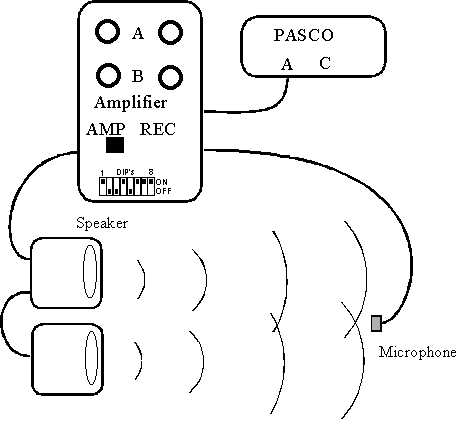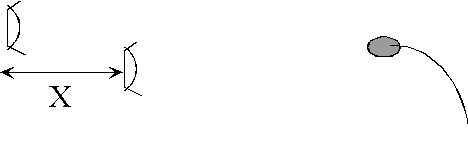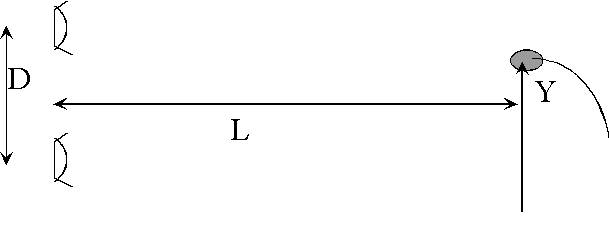Laboratory #7: Interference
Objective:
In this lab we will investigate some examples of the interference of sound waves using two speakers and a microphone. We will use the same frequency in each speaker, giving the same wavelength. Remember, spacing = lL/D.
Equipment:
- Computer and PASCO software.
- Two speakers.
- Amplifier box in AMP setting.
- Microphone on optical rail with ruler.
Diagram: Top View.

Part A:

Part B:

Instructions:
- Start up PASCO software and open the file Lab7.sws.
- Place the speakers and microphone as shown for Part A. Start function generator. Use a sine wave of 2000-3000 Hz and an amplitude of 0.1 V.
- Start with the speakers side by side and note the signal level from the microphone on the oscilloscope.
- Slowly move one speaker back while watching the oscilloscope. You will see the signal start to decrease and then increase as you move it back. Record the distance back where you find a minimum and note the amplitude.
- Repeat 5) but move the other speaker back. Moving one or the other will give you a better minimum.
- Move the speaker that gave a better minimum into the position that gave the best minimum. Now block the speaker with a notebook, or something of that size. What happens to the signal? This is one of the strangest aspects of waves: under certain conditions, blocking the source of part of a signal can actually INCREASE the signal level.
- Repeat 5), 6), and 7) by placing your ear on the level of the speakers so that you can actually hear these effects.
- Now arrange the speakers and microphone as in Part B. Use a frequency of 5000 Hz. You should align the speakers with the crack between the tables and move the microphone along the other crack. Use a separation, D, between 20-30 cm and a distance, L, of about 50 cm.
- As you move the microphone along the y direction, record the positions where the signal is a maximum and a minimum. Mark the two best minima, i.e. the positions where the signal is the smallest.
- Repeat 10) for a second value of D.
- As in Part A, also place your ear on the level of the speakers and move your head along the y direction to hear the maxima and minima.
DATA:
PART A:
|
Method |
Position of first minimum |
|
Speaker 1, mic |
|
|
Speaker 2, mic |
|
|
Speaker 1, ear |
|
|
Speaker 2, ear |
|
PART B:
D = L =
|
Position (cm) |
Signal at maximum or minimum |
Separation between
maxima and minima. |
| |
|
|
|
|
|
| |
|
|
| |
|
|
| |
|
|
| |
|
|
| |
|
|
| |
|
|
D = L =
|
Position (cm) |
Signal at maximum or minimum |
Separation between
maxima and minima. |
| |
|
|
|
|
|
| |
|
|
| |
|
|
| |
|
|
| |
|
|
| |
|
|
| |
|
|
Questions:
- First, find the wavelength of sound with a frequency of 5000 Hz.
- For Part A, how far back should you have to move the speaker in order to go from constructive interference to destructive interference? Does this agree with your measurement?
- Did it make a difference which speaker you moved? Why might this be?
- How can it happen that blocking the sound from a speaker can actually increase the sound level at the microphone?
- For Part B, find the average value for the separation between adjacent maximum and the separation between adjacent minimum. Also, calculate the value that you expect. How close are these values in percentage?



